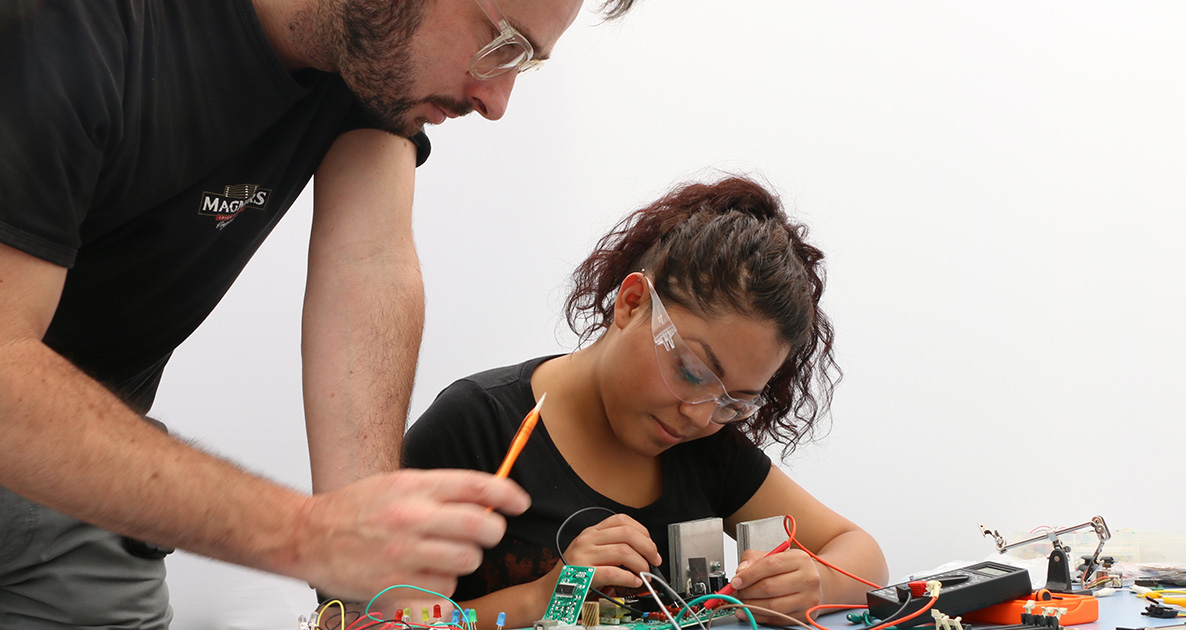Pathways to the Post-Pandemic Workforce
Career and Technical Education Connects the Dots

MDRC is dedicated to learning what works to improve the well-being of people in poverty. During these challenging times, our “Ideas and Evidence 2021” briefs provide policymakers with fact-based research and analysis to help them address critical issues in social policy and education.
The field of career and technical education (CTE) has been evolving in recent years. Formerly known as vocational education, high-quality CTE programs are being championed by educators, policymakers, and employers alike, who recognize that these robust models can help high school students acquire the skills, training, and postsecondary credentials they need to thrive in the twenty-first century workforce.
The economic recession triggered by the COVID-19 pandemic has only magnified the urgency of that mission. It has become even more critical to develop viable pathways — including certificates, short- and long-term training opportunities, and two- or four-year postsecondary degrees — that prepare students for jobs in high-demand industries with middle-class wages and possibilities for advancement.
What types of CTE programs work best?
Multifaceted programs and whole school CTE models can improve students’ academic and earnings outcomes.
High-quality CTE programs generally bundle together multiple learning and training components. That can include career-based coursework combined with rigorous academics, dual-enrollment initiatives (with students earning college credit in partnership with postsecondary institutions), the opportunity to earn industry-recognized credentials, and work-based learning such as mentoring and job shadowing, internships, and apprenticeships. There is also a growing emphasis on teaching industry-transferable “soft skills” such as problem solving, collaboration, communication, and tech literacy, among others.
While there is some evidence that individual program components can make an impact on their own, research shows that schools and programs that bundle together several elements provide more holistic learning experiences that can increase high school credit accumulation toward graduation and improve other academic outcomes, including test scores, graduation rates, and postsecondary enrollment.
Here are examples of programs that improved academic outcomes:
- New York City P-TECH 9-14 is a six-year high school program that teams up with an employer partner to provide students with work-based learning opportunities. In addition, students simultaneously earn a high school diploma and a cost-free two-year applied associate’s degree from a local community college. A study of the program found that by the end of three years of high school, P-TECH 9-14 students in the research group had earned more high school credits toward graduation than students in the control group, and were more likely to pass New York State Regents exams at a level indicating a readiness for college coursework.
- Early College High Schools are aimed at improving the high school graduation rates and postsecondary enrollment of underrepresented students. The programs, which help students earn up to two years of college credit before graduating high school, led to increases in enrollment in college preparatory coursework and improved high school attendance, according to a study of the model.
- Regional vocational technical high schools (RVTHS) in Philadelphia, Connecticut, and Massachusetts that engage students in CTE programs increased credit accumulation and improved math performance and graduation rates, studies show.
Here are examples of programs that increased earnings:
- The study of RVTHS in Connecticut also found that students who attended these schools had earnings, on average, that were 31 percent higher by the time they were 23 years old than those of similar students who attended regular public comprehensive high schools in the state.
- A large study of Career Academies found that eight years after graduation, students who had attended a Career Academy earned an average of 11 percent more a year ($2,088 in 2006 dollars) than students who did not attend one of the academies.
Who benefits the most from CTE programs?
CTE seems to be particularly advantageous for young men, who overall have experienced lower high school graduation rates and college degree attainment than young women over the past several decades; that gender difference affects students across race and ethnic subgroups.
For example, the earnings impacts in the Career Academies study and the study of Connecticut RVTHS were driven entirely by the positive impacts for young men. A smaller study of a single Career Academy in North Carolina also found positive impacts for young men on academic outcomes such as high school graduation rates. In addition, a randomized controlled trial study of a high school internship program found positive impacts on college enrollment for young men and persistence after two years.
Recommendations
- Multifaceted programs that combine different career learning opportunities and create easy transitions for students after high school can be good models for improving both academic and earnings outcomes.
- Various studies highlight that the programs can be whole school models, such as P-TECH 9-14 and RVTHS, in which all students are engaged in CTE opportunities. Or, like Career Academies, they can be embedded in more traditional high schools.
- High-quality CTE also appears to provide avenues for young men, many of whom have struggled to attain academic outcomes on par with their female counterparts.
- Employer involvement is critical.
- Employer involvement in the educational experiences of young people is a common element in successful CTE programs. Finding ways to foster the connection between school and work may be key to preventing students from falling through the cracks — providing meaningful pathways to industry-recognized credentials, postsecondary education, and jobs in high-demand industries.
As students prepare to enter the post-pandemic labor market, CTE programs are working to ensure that school-to-work connections are developed and fostered in ways that are equitable for all and ensure access to opportunity, particularly during a time of increased remote education and work experiences.







